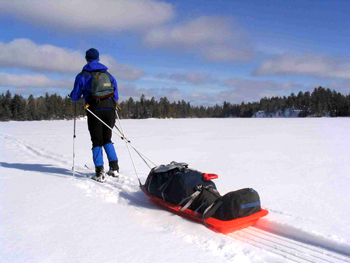Pulk for the Bulk
As long as humans have lived in winter environments they have been designing devices for dragging or pulling loads across the snow and ice.
At least that's according to Ed Bouffard, a former instructor with the National Outdoor Leadership School who runs Eds Wilderness Systems LLC out of his home in St. Cloud, Minn.
Bouffard makes pulks, which are essentially sleds you pull to haul gear while skiing, snowshoeing, or hiking in the white stuff. Pulks are used by polar explorers, mountaineers, and other wintertime backcountry wanderers who'd rather pull a load than put it on their back.

Sometimes it's good when your gear's a drag.
Pulks are often employed on expeditions -- like climbing Denali, or skiing to the South Pole -- as you can pull more than 100 pounds, while putting that much weight on your back is impossible.
Eds Wilderness Systems offers a free 35-page booklet on its website (www.skipulk.com) on making your own pulk, including instructions for drilling holes and rigging fiberglass poles to a sled, attaching the poles to a hip belt, tagging on fins for tracking and stabilization, and using it in the wilderness.
Pulk poles and hip belts are available for sale on the company's website.
Or, the company sells complete pulk kits starting at $160.
The kit I tested, the $188 Backcountry Outfit, includes a 5-foot-long plastic sled, fiberglass poles, a hip belt, fins, and extra parts (in case things are lost or damaged in the backcountry). The complete setup weighed about 10 pounds.
I tested it out skiing on the frozen surface of a chain of lakes near my house, pulling loads up to about 120 pounds. I skated and skied classic style, and the pulk pulled easy both ways on flat surfaces.
After overcoming inertia, momentum kicked in and the pulk slid along behind. On hills the pulk was much harder to pull.
Up to 50 pounds was fairly unnoticeable on my short ski outings, especially on flat ground. More than that and the pulk started to feel like a real lug.
The hip belt was comfortable, and the system's poles clip in via small carabiners, letting you easily drop the pulk when needed. Buckle-equipped webbing straps over the top of the sled let you tie down gear.
For smaller loads -- say less than 25 pounds -- I found a backpack to be more comfortable and efficient than the Backcountry Outfit.
But for big loads on long wilderness hauls, nothing does the job like a pulk.
(Stephen Regenold writes The Gear Junkie column for eight U.S. newspapers; see http://www.THEGEARJUNKIE.com for video gear reviews, a daily blog, and an archive of Regenold's work.)
At least that's according to Ed Bouffard, a former instructor with the National Outdoor Leadership School who runs Eds Wilderness Systems LLC out of his home in St. Cloud, Minn.
Bouffard makes pulks, which are essentially sleds you pull to haul gear while skiing, snowshoeing, or hiking in the white stuff. Pulks are used by polar explorers, mountaineers, and other wintertime backcountry wanderers who'd rather pull a load than put it on their back.

Sometimes it's good when your gear's a drag.
Pulks are often employed on expeditions -- like climbing Denali, or skiing to the South Pole -- as you can pull more than 100 pounds, while putting that much weight on your back is impossible.
Eds Wilderness Systems offers a free 35-page booklet on its website (www.skipulk.com) on making your own pulk, including instructions for drilling holes and rigging fiberglass poles to a sled, attaching the poles to a hip belt, tagging on fins for tracking and stabilization, and using it in the wilderness.
Pulk poles and hip belts are available for sale on the company's website.
Or, the company sells complete pulk kits starting at $160.
The kit I tested, the $188 Backcountry Outfit, includes a 5-foot-long plastic sled, fiberglass poles, a hip belt, fins, and extra parts (in case things are lost or damaged in the backcountry). The complete setup weighed about 10 pounds.
I tested it out skiing on the frozen surface of a chain of lakes near my house, pulling loads up to about 120 pounds. I skated and skied classic style, and the pulk pulled easy both ways on flat surfaces.
After overcoming inertia, momentum kicked in and the pulk slid along behind. On hills the pulk was much harder to pull.
Up to 50 pounds was fairly unnoticeable on my short ski outings, especially on flat ground. More than that and the pulk started to feel like a real lug.
The hip belt was comfortable, and the system's poles clip in via small carabiners, letting you easily drop the pulk when needed. Buckle-equipped webbing straps over the top of the sled let you tie down gear.
For smaller loads -- say less than 25 pounds -- I found a backpack to be more comfortable and efficient than the Backcountry Outfit.
But for big loads on long wilderness hauls, nothing does the job like a pulk.
(Stephen Regenold writes The Gear Junkie column for eight U.S. newspapers; see http://www.THEGEARJUNKIE.com for video gear reviews, a daily blog, and an archive of Regenold's work.)


 Subscribe to Stephen's RSS Feed
Subscribe to Stephen's RSS Feed

1 Comments:
These are also great kid-haulers. You should also check out the following manufacturers:
Fjellpulken of Norway at http://www.fjellpulken.no/index.php?lang=en
and
Wilderness Engineering at http://wildernessengineering.com/index.html
I own a WE Kidershuttle and highly recommend it.
Post a Comment
<< Home